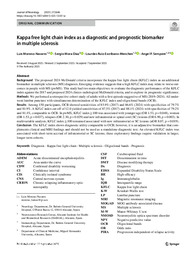Por favor, use este identificador para citar o enlazar este ítem:
https://hdl.handle.net/11000/37760Registro completo de metadatos
| Campo DC | Valor | Lengua/Idioma |
|---|---|---|
| dc.contributor.author | Moreno-Navarro, Luis | - |
| dc.contributor.author | Mora‑Diaz, Sergio | - |
| dc.contributor.author | Ruiz-Escribano, Lourdes | - |
| dc.contributor.author | Perez-Sempere, Angel | - |
| dc.contributor.other | Departamentos de la UMH::Medicina Clínica | es_ES |
| dc.date.accessioned | 2025-10-31T10:39:46Z | - |
| dc.date.available | 2025-10-31T10:39:46Z | - |
| dc.date.created | 2025 | - |
| dc.identifier.citation | Journal of Neurology. 2025 Sep 23;272(10):646 | es_ES |
| dc.identifier.issn | 1432-1459 | - |
| dc.identifier.uri | https://hdl.handle.net/11000/37760 | - |
| dc.description.abstract | Background The proposed 2024 McDonald criteria incorporate the kappa free light chain (KFLC) index as an additional biomarker in multiple sclerosis (MS) diagnosis. Emerging evidence suggests that a high KFLC index may relate to worse outcomes in people with MS (pwMS). This study had two main objectives: to evaluate the diagnostic performance of the KFLC index against the 2017 and proposed 2024 clinico-radiological McDonald criteria, and to explore its prognostic significance. Methods We performed a retrospective cohort study of adults with a first episode suggestive of MS (2019–2024). All underwent lumbar puncture with simultaneous determination of the KFLC index and oligoclonal bands (OCB). Results Among 150 participants, OCB showed sensitivities of 85.9% (2017) and 86.6% (2024) with specificities of 79.7% and 81.9%. A KFLC index cut-off of 12.0 yielded sensitivities of 87.5% (2017) and 88.1% (2024) with specificities of 79.2% and 81.4%, comparable to OCB. In pwMS, KFLC index ≥ 100 was associated with younger age (OR 1.53, p = 0.048), women (OR 1.53, p = 0.037), relapses (OR 2.30, p = 0.029) and new infratentorial or spinal cord (SC) lesions (OR 6.90, p = 0.003). In multivariable analysis, KFLC index ≥ 100 remained associated with new infratentorial or SC lesions (aOR 8.07, p = 0.019). Conclusion The KFLC index shows diagnostic utility comparable to OCB; however, it is an adjunctive biomarker that complements clinical and MRI findings and should not be used as a standalone diagnostic test. An elevated KFLC index was associated with short-term accrual of infratentorial or SC lesions; these exploratory findings require validation in larger, longer-term cohorts. | es_ES |
| dc.format | application/pdf | es_ES |
| dc.format.extent | 14 | es_ES |
| dc.language.iso | eng | es_ES |
| dc.publisher | Springer | es_ES |
| dc.rights | info:eu-repo/semantics/openAccess | es_ES |
| dc.rights | Attribution-NonCommercial-NoDerivatives 4.0 Internacional | * |
| dc.rights | Attribution-NonCommercial-NoDerivatives 4.0 Internacional | * |
| dc.rights.uri | http://creativecommons.org/licenses/by-nc-nd/4.0/ | * |
| dc.subject | Diagnosis | es_ES |
| dc.subject | Kappa free light chain | es_ES |
| dc.subject | Multiple sclerosis | es_ES |
| dc.subject | Oligoclonal bands | es_ES |
| dc.subject | Prognosis | es_ES |
| dc.subject.other | CDU::6 - Ciencias aplicadas::61 - Medicina | es_ES |
| dc.title | Kappa free light chain index as a diagnostic and prognostic biomarker in multiple sclerosis | es_ES |
| dc.type | info:eu-repo/semantics/article | es_ES |
| dc.relation.publisherversion | https://doi.org/10.1007/s00415-025-13381-w | es_ES |

Ver/Abrir:
Kappa free light chain index as a diagnostic and prognostic biomarker.pdf
1,32 MB
Adobe PDF
Compartir:
 La licencia se describe como: Atribución-NonComercial-NoDerivada 4.0 Internacional.
La licencia se describe como: Atribución-NonComercial-NoDerivada 4.0 Internacional.
.png)